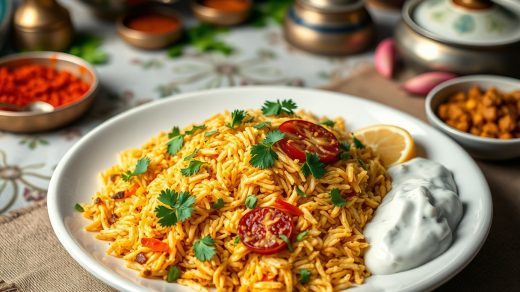Cuisine is a delightful amalgamation of flavors, especially when it comes to Indian food, which boasts a rich tapestry of spices and textures. To enhance your culinary experience, you may want to consider complementary dishes and accompaniments that elevate your meal. From traditional breads like naan and roti to refreshing sides such as raita and pickles, there are countless options to explore. In this post, you will discover the best pairings to enjoy with Indian cuisine, ensuring that your dining experience is both satisfying and memorable.
Key Takeaways:
- Accompaniments: Indian food is often best enjoyed with various side dishes such as raita (yogurt sauce), pickles, and papad (crispy lentil wafers) to enhance flavors.
- Rice Varieties: Serve dishes like biriyani or jeera rice for a hearty base, pairing well with rich curries and gravies.
- Breads: Traditional Indian breads such as naan, roti, and paratha are perfect for scooping up curries and sauces.
- Drinks: Complement your meal with refreshing drinks like lassi (yogurt drink) or chai (tea) to balance the spices.
- Desserts: End your meal with gulab jamun or kheer to satisfy your sweet tooth and cleanse the palate.
Complementary Dishes to Indian Food
Your dining experience can be greatly enhanced by choosing the right complementary dishes to accompany your Indian meal. If you’re unsure about what to select, you might want to check out I am about to try Indian food for the first time. What is a … for insights and suggestions.
Breads and Baked Goods
Indian cuisine features an array of delicious breads and baked goods that are perfect for scooping up curries and gravies. Options like naan, roti, and paratha not only complement the flavors of your main dishes but also enhance the overall texture and experience of your meal.
Rice Varieties
One of the most beloved staples in Indian cuisine is rice. Many dishes are served alongside fragrant basmati rice or flavorful pulao, showcasing the versatility of this grain. You can choose from plain steamed rice or spiced variations to brighten up your meal.
To further enrich your dining experience, consider trying biryani, a dish that combines rice with marinated meat or vegetables, slow-cooked to perfection. This aromatic rice dish is often layered with spices and complemented by yogurt-based sides, offering a delightful mix of flavors and textures.
Side Dishes
Food in Indian culture often comes with a variety of enticing side dishes. These can include chutneys, pickles, or salad, that bring additional flavors and balances the richness of main dishes, making your meal even more enjoyable.
It’s also necessary to consider pairing your meal with raita, a cooling yogurt-side dish that can tame the heat from spicy fare. Incorporating a mix of side dishes allows you to explore a wider range of tastes and textures, elevating your Indian dining experience.
Popular Beverage Pairings
Some beverages perfectly complement Indian cuisine, enhancing the rich and diverse flavors of your meal. By understanding the various options available, you can elevate your dining experience, whether through traditional drinks or refreshing non-alcoholic choices. Here’s a breakdown of some popular beverage pairings with Indian food.
Traditional Indian Drinks
An integral part of Indian culture, traditional drinks like lassi (a yogurt-based treat) and chaas (buttermilk) offer cooling effects that balance the spiciness of your meal. These beverages not only aid digestion but also enhance the authentic experience of enjoying Indian cuisine.
Non-Alcoholic Options
With so many refreshing choices, you can easily find non-alcoholic options that go well with your meal. Soft drinks, fresh juices, and flavored water can cleanse your palate and complement the robust spices in your dishes.
For instance, a spicy biryani pairs wonderfully with a sweet mango lassi or a chilled lemonade. These beverages provide a sweet contrast to the heat of your curries, ensuring a more balanced and enjoyable experience. You might also enjoy a tamarind juice, which adds a tangy kick that perfectly offsets the flavors of rich gravies.
Alcoholic Pairings
On the other hand, if you prefer alcoholic beverages, options such as beer, wine, or cocktails can enhance the flavors of your Indian food. Light beers and aromatic wines often help in cutting through the richness of various dishes.
Pairings like a crisp lager or a fruity Riesling can enhance flavors without overwhelming your palate. Additionally, you might consider spiced cocktails that incorporate ingredients like ginger or cardamom, which harmonize beautifully with the spices found in Indian cuisine, delivering a truly unique dining experience.
Regional Food Pairings
Unlike other cuisines that may have a universal approach to pairings, Indian food is wonderfully diverse, rich in regional flavors that dictate what you should enjoy alongside your meals. Each region’s culinary influences create unique combinations that enhance your overall dining experience. Understanding these regional pairings will elevate your meal and introduce you to the culinary tapestry of India.
Northern Indian Cuisine
For Northern Indian cuisine, you’ll find that buttery naan and fragrant basmati rice are perfect companions to rich, creamy dishes like butter chicken or paneer makhani. Accompany these with tangy pickles and cooling raita, which balance the robust flavors beautifully, ensuring a well-rounded meal.
Southern Indian Specials
Indian southern cuisine is often paired with rice and an array of lentil-based dishes, providing a wholesome and nutritious experience. You can savor favorites like dosas or idlis alongside coconut chutneys and sambar, creating a delicious combination of textures and flavors.
Indian southern specialties reflect a harmonious blend of spices and fresh ingredients. Dosas, thin, crispy crepes, and idlis, soft rice cakes, are staples that deserve to be enjoyed with a variety of side dishes. Serve them with coconut chutney, tangy tomato chutney, or the traditional sambar, a lentil-based stew incorporating spices and vegetables for a nourishing and satisfying meal.
Eastern and Western Indian Delights
Southern flavors in Eastern and Western regions often incorporate seafood, while the staple of dal and bhaji enhances the meal experience. Rice, accompanied by fish curry or spicy masalas, takes center stage along with sweet desserts like rasgulla or gulab jamun to complete your culinary journey.
As you explore Eastern and Western Indian delights, you’ll discover a wonderful contrast in flavors and cooking methods. In coastal areas like West Bengal, fish is a main ingredient, often enjoyed with rice and mustard sauces. Meanwhile, Western dishes feature aromatic spice blends, enhancing your taste experience. Enjoying these regional delicacies alongside traditional sweet treats rounds off the meal to perfection, introducing you to the exciting spectrum of Indian cuisine.

Dietary Considerations
Many people have specific dietary preferences or restrictions that can influence their choices when enjoying Indian cuisine. Understanding these considerations is necessary to fully appreciate all that this flavorful and diverse food has to offer.
Vegetarian and Vegan Options
With a rich array of plant-based ingredients, Indian food provides numerous vegetarian and vegan options for you to enjoy. Dishes such as chana masala (chickpea curry), palak paneer (spinach with cheese), and lentil dal are not only satisfying but also packed with nutrients.
Gluten-Free Alternatives
Options abound for those following a gluten-free diet. Many traditional Indian dishes are naturally gluten-free, thanks to their reliance on rice, lentils, and a variety of vegetables. Popular choices include dosa (rice crepes), idli (steamed rice cakes), and various curries served with rice.
Plus, if you’re avoiding gluten, you might want to explore the world of Indian flatbreads made from gluten-free flours, such as besan (chickpea flour) for papad or jowar (sorghum) flours for bhakri. Make sure to check each dish’s ingredients, as some pre-packaged items may contain hidden gluten sources.
Spicy Tolerance
An important aspect of enjoying Indian food is understanding your spicy tolerance. While many dishes are renowned for their heat, you can easily find milder variations to suit your palate. Don’t hesitate to communicate your preferences when ordering.
This ensures that you can fully enjoy the many flavors without overwhelming your taste buds. Indian cuisine varies greatly by region, so you might find that some dishes from northern India are milder compared to those from the south. Always feel free to ask for adjustments or recommendations based on your spice comfort level!
Summing up
To wrap up, when you enjoy Indian food, enhance your meal with complementary options such as basmati rice, naan, or paratha to soak up flavorful gravies. Don’t forget cooling sides like raita or a refreshing salad to balance spices. For a complete experience, consider pairing your meal with traditional beverages like lassi or masala chai. These additions not only elevate your dining experience but also allow you to appreciate the diverse flavors and textures Indian cuisine has to offer.
Q: What are some traditional side dishes to serve with Indian food?
A: When enjoying Indian cuisine, it’s common to accompany your meal with a variety of traditional side dishes. Popular options include:
- Naan or Roti: These are types of Indian bread that are perfect for scooping up curry or lentils.
- Raita: A yogurt-based side dish that helps balance the spices. Variants include cucumber raita and boondi raita.
- Pickles (Achar): Indian pickles made from lemon, mango, or mixed vegetables add a tangy kick to the meal.
- Salad: A simple salad of onions, cucumbers, and tomatoes dressed with lemon juice can offer a refreshing contrast.
- Papad: Crispy lentil wafers that are often served as a starter or side for added crunch.
Q: What beverages pair well with Indian food?
A: The right beverage can enhance the dining experience when indulging in Indian cuisine. Here are some recommended choices:
- Mango Lassi: A sweet and creamy yogurt drink that complements spicy dishes and helps cool down the palate.
- Chai: Traditional Indian tea made with milk and spices, enjoyed either hot or cold, can provide a pleasant finish to a meal.
- Beer: A light lager or wheat beer works well with spicy foods, while IPAs can add a hoppy contrast to richer curries.
- Wine: For wine lovers, a slightly chilled Riesling or Sauvignon Blanc is a great match for Indian flavors.
- Fruit Juices: Fresh juices like pineapple or lime offer refreshing sips that can cleanse the palate.
Q: How can I make a complete meal with Indian food?
A: Creating a balanced and complete meal with Indian food involves combining different elements for a satisfying dining experience. Here’s how to do it:
- Main Dish: Choose a protein-packed curry like chicken tikka masala, paneer butter masala, or chana masala for a vegetarian option.
- Accompaniments: Include rice (like basmati or jeera rice) alongside your curry to soak up the sauce, along with dal (lentils) for extra protein.
- Side Dishes: Add a couple of sides such as naan or raita to further enhance the meal’s diversity and flavor.
- Dessert: Don’t forget to finish off with a sweet treat like gulab jamun or jalebi to cleanse the palate after a spicy meal.
- Presentation: Serve everything family-style; placing all dishes on the table encourages sharing and creates a communal dining atmosphere.



